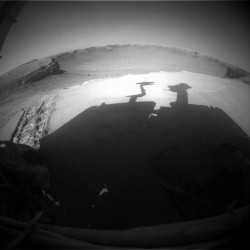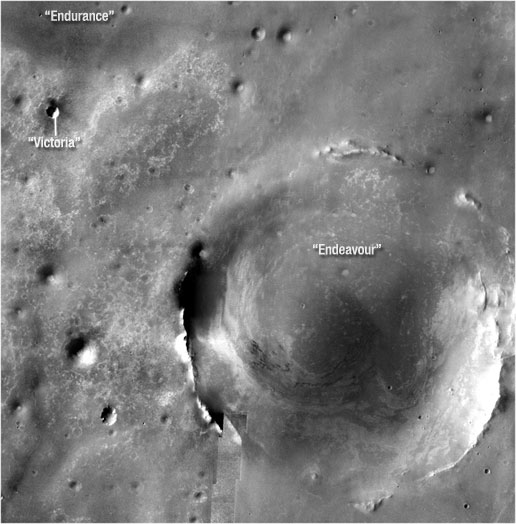[/caption]
Opportunity, the intrepid Mars Exploration Rover, is going to put the pedal to the metal and head out for a crater nearly 12 kilometers (7 miles) away. That would match the distance the rover has traveled since landing in 2004. But the call of the unknown is compelling the rover science team to make the attempt. “We may not get there, but it is scientifically the right direction to go anyway,” said Steve Squyres, principal investigator for the science instruments on Opportunity and its twin rover, Spirit. For an “aging” rover (what age is 4 in rover years?), this might be setting the bar pretty high. But maybe it’s the journey and not the destination.
“This is a bolder, more aggressive objective than we have had before,” said John Callas, the project manager the rovers. “It’s tremendously exciting. It’s new science. It’s the next great challenge for these robotic explorers.”
“This crater is staggeringly large compared to anything we’ve seen before.” The crater, named Endeavour, is 22 kilometers (13.7 miles) across. “I would love to see that view from the rim,” Squyres said. “But even if we never get there, as we move southward we expect to be getting to younger and younger layers of rock on the surface. Also, there are large craters to the south that we think are sources of cobbles that we want to examine out on the plain. Some of the cobbles are samples of layers deeper than Opportunity will ever see, and we expect to find more cobbles as we head toward the south.”
The rover team estimates Opportunity may be able to travel about 110 yards each day it is driven toward the Endeavour crater. Even at that pace, the journey could take two years. But why not go for it, and see how long the rovers can last?

Opportunity, like Spirit, is well past its expected lifetime on Mars, and might not keep working long enough to reach the crater. However, two new resources not available during the 4-mile drive toward Victoria Crater in 2005 and 2006 are expected to aid in this new trek.
One is imaging from orbit of details smaller than the rover itself, using the High Resolution Imaging Science Experiment (HiRISE) camera on NASA’s Mars Reconnaissance Orbiter, which arrived at the Red Planet in 2006.
“HiRISE allows us to identify drive paths and potential hazards on the scale of the rover along the route,” Callas said. “This is a great example of how different parts of NASA’s Mars Exploration Program reinforce each other.”
Also, Opportunity now has a better “brain” for driving across the the plains of Mars. A new version of flight software uplinked to Opportunity and Spirit in 2006, boosts their ability to autonomously choose routes and avoid hazards such as sand dunes.
During its first year on Mars, Opportunity found geological evidence that the area where it landed had surface and underground water in the distant past. The rover’s explorations since have added information about how that environment changed over time. Finding rock layers above or below the layers already examined adds windows into later or earlier periods of time.
Source: JPL


“He’ll never make it” (guess the animated character)
… which won’t matter anyway. As you say, it’s all in the travel.
I have been puzzling about something for a while and I guess this is as good an occasion as any other to pose the question: why is it that Opportunity travels so much, while Spirit travels so little, mostly sitting around Home Plate? Is it just Spirit’s dragging wheel or is there more to it than that?
And an off topic post scriptum: anyone knows what happened to the Planetary Society website?
I wonder if the public at large even knows that these little things are still valiantly powering along on the surface of Mars?
One day, there will be a news story informing us of demise of one of these intrepid little explorers, and people won’t even remember what they are or what they’ve been doing for us all these past years…
Just a thought.
Jorge-
Plainly put, Spirit doesn’t have the energy to do anything else but sit right now. During the winter months it needed 90 watt hours of power to run the heater to keep it warm, and there wasn’t much more than that available from the solar panels. Now the panels are generating about 250 watt hours, so Spirit’s recharging her batteries and getting ready to do some moving sometime soon.
The PS website is working now.
Nancy
Yes, Nancy, but still… For the past year or so, Opportunity explored Victoria crater, went perhaps a quarter way around it, started to go inside, retreated after the arm glitch, in sum, walked around. Spirit, on the other hand, just stayed in the same place, shooting some pictures from time to time, and hasn’t left the Home Plate region for about two (Earth) years. In fact, most of the 7km it travelled so far (against Oppy’s 12) were travelled in the beginning of the mission. Two of our years is about one martian year, including both summer and winter, and also includes a number of months before the dust storm they both went through. So surely this hasn’t just to do with energy levels? This is what puzzles me. If not the wheel, what’s keeping it there?
@Jorge: It is the energy levels. Try to find out how far away from the equator Spirit is, and how far away Opportunity is.
Well, this picture leads me to post the adage:
“There is always a bigger crater.”
Remember when the orbit pictures showed Victoria as being this humongous blasted pit of exposed rock layers that totally put Endurance to shame?
And now you have this behemoth.
But it looks kind of like a comparison between Meteor Crater in Arizona and typical large, old craters on Earth, like the Noerdlinger Ries in southern Germany. Endeavour may not show much of an interesting view from an ill-defined rim…
Heh… I did try to find out how far from the equator they were, in the rovers website, but somehow didn’t find that piece of info. And now I had this brilliant, unheard of, idea of checking… wikipedia. Dumb-a-dumb-idiboo.
And there it is. Opportunity landed at 1.94° S, Spirit at 14.5718° S.
Indeed a bit of a difference. I guess that plus the wheel (a dragging wheel should require more energy to move around), plus, maybe, more dust on the solar cells (is there? I think I saw that info in the Planetary society site a while back, but it seems to be down again… ah, but then I found out in the rovers’ website that Opportunity’s energy input is currently more than twice Spirit’s, so Spirit is bound to be dustier), all combined may be enough of an explanation. Home Plate surely doesn’t seem to be interesting enough to justify in itself that lengthy stay.
What this story tells us is that we have to adjust our thinking as we get more experience of using these small rovers. One thought that has come to mind is, in the future, is it at all possible to include a stored balloon, tether and a capsule of compressed helium so that, when we get to one of these long treks, instead of wasting two years travel, we just deploy the balloon and let the surface wind take us there?
We could also add a small camera to the top of the tether and take images of the surface as we travel along and again, before we release the tether, take a good look at the surrounding terrain where we have landed.?
I agree with Chris Coles (I think it would have to be a hot air vs. helium balloon), and while were at it, equip the thing with a small back-up nuke battery and a wiper or compressed gas blaster to keep the solar panels clean.
I’m still a big fan of the Rovers. The discovery of “blueberries” by Opportunity was fantastic….and it’s still not known if there are any biological relationships there (are they life? do they serve as a home for microbial life, like other rocks? were they formed in part by a biological action?). I think there’s some historic interest as well (do “bleuberries get covered by dust, then uncovered by winds, and so contribue to the seasonal “wave of darkening” seen by Slipher, Kuiper, and many other great astronomers?) I hope the rovers last long enough to make more great discoveries.
7 miles = 12320 yards… at 110 yards a day – the rover could make the journey in 112 days – not 2 years
…or am I missing something?
it’d be nice to see if they can set a few distance records with the autonomous driving and improved maps. We don’t have to stop at *every* cobble, do we?
@GregG, Looks like your math is good. Nancy may have slipped from days to months, as 112 months would be just over 2 years……….maybe?
Aaaarrghh!! I meant weeks! Duh Oh!!!!!!
@GregG, I believe the rovers can’t move for a few months each year due to winter. And maybe they can’t be run on too many consecutive days (could lead to excessive wear of the mechanical parts…)
Luckily the Martian wind erodes the wind blown soil into a relatively benign dust. If the rovers were on the Moon, then the sharp, jagged regolith would have killed them long ago.
Opportunity the little marsrover that did. It still does. keep up the good work.